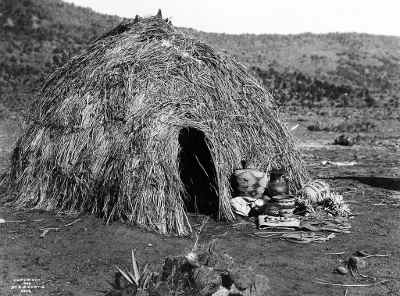How To Build Temporary Shelter Quick And Easy

You may want to build a log cabin or some other grand structure, but those take time. You will need a place to stay while you build a more permanent home. And that is what this article teaches. This quick and easy improvised structure is more than just an open lean to structure which might serve for a night or two or in cases where you are moving and still looking for a place to set up permanently. This structure is for when you have found the area you plan to stay at permanently or semi-permanently. It could be also an outpost hut, possibly where season changes bring you to this area, but not all year long. Let's get started.
The first step is to find or make a cutting implement. Hopefully you will at least have a knife, but if not finding some rocks to make an ax head with, even without the wood handle, could be enough. You can go to the tools and stuff section to get ideas. Let's continue.
Next step is to clear an area for the hut. A fairly flat area that is high and dry is highly recommended. Now dig a hole about 1 foot deep. How deep will vary greatly depending on how rocky your soil is. Each hole should be just big enough to fit the pole in. Large end goes in the hole. The more wispy end will be at the top. If you are building in dirt then the hole needs to be closer to a foot deep. Rocky soil you can get away with a shallower hole.
The poles will be under tension. The ends buried in the hole will be pushing outward due to the tension they will be under. If the soil become mud when it rains a shallowly buried pole will push out of the hole sideways. An alternative method to burying is to run a stick across the floor of the hut and tie them to the poles to hold the poles rigidly in place.
After you get your first pole is set. Dig the hole for its sister pole directly on the opposite side of the future hut. These two poles should be at least as far apart from each other as you are tall. This will allow you to stretch out when sleeping. Bigger is nicer but is harder to build due to it taking more material. Let your needs determine the size.
For successive pairs of poles space them evenly in a hexagon pattern if you have 6 poles, an Octagon pattern for 8 poles etc.
Once the poles are set you need some type of cordage. Vines will likely be the most readily available choice if you don't have a supply of string. And really if you do have string I would use vines or some other form of natural cordage anyway. String or cordage is a precious commodity.
With the cordage you will need to pull the sister pairs of poles together so that they meet and overlap in the direct center of the hut. Bind together with the cordage. If one pole is much stiffer than the other it will form instability in the structure. This is why you should match the sister pairs as closely to each other as possible. Continue to pull in sister poles and have them all overlap in the center and tie off. You should have the skeleton framework of your hut. It sort of resembles a teepee. I like this design better than the straight pole teepee design because it takes less material. The walls will not start closing together until the poles start bending. The bending occurs more and more as you go up. This allows for more headroom than the teepee design with much shorter poles.
Now you need to add cross bracing. Secure cut sticks to neighboring poles. Basically you will make a number of circular rings with these cross bracing poles. These cross bracing poles will add to the strength of the structure and will give support to your wall material. How many of these cross braces you need will depend on what your walls are made of. If you are using leaves for a wall then that will mean the leaf size will determine the spacing of the cross braces. If you have huge elephant ear leaves or palmetto leaves for your wall material then the spacing will be larger than will be required for smaller leaves.
The wall material you use is extensive. And the wall material doesn't all need to be of the same material either.
If rocks are available then the base of your hut can be rocks. Just stack them between the poles. You can use clay to fill in the holes. You will not be able to use rocks the entire way up due to the curvature of the walls. Rocks do make a great weather resistant choice if they are available.
Another wall material is simply sticks. Lash sticks from pole to pole, building up from the bottom as you go leaving no intentional gaps. This isn't air tight but works well. You can plaster clay on the walls to seal them even better just like with rocks.
Bark is another option. Bark can be lashed to the cross bracing. Be sure to overlap the bark. Start at the bottom and work up. The bark from above will lay on top of the bark piece below it so that it sheds water outward and doesn't funnel it into the hut itself. Basically you are making bark shingles if that makes sense.
Grass! Grass is another excellent option. If you have a field close-by, you can bundle the tall grass together at one end and secure each bungle to the cross bracing. Overlap as you build up to shed water. This method works well for shedding water.
Probably the faster wall material to use is huge leaves if they are available. So if you are lucky enough to have palmettos or some other large leaved plant nearby then certainly consider those as a building material.
Cap it off... Or not! As you build towards the top you will have to make a decision. Should you leave a hole at the top? Having a hole at the top will allow rain to enter, but allow smoke to escape. If in a desert leave it open. If in a rainforest you better cap it off.
Build a cap, don't build the wall higher. I prefer to build a removable cap. That allows me to put it on or take it off as needed. Basically if you need you need to build a hat that you can set on the top of the structure from outside. You aren't going to be climbing on this structure so you will place the hat on and take it off with a long pole.
I like to have a loop sticking up at the top center for this purpose and I like to have some cordage dropping down into the hut also. The drop down string can be tied off to a crossing pole to hold it down and not get blown away like a kite in windy conditions.
This cross pole is simply a pole that runs horizontally from two opposite supporting poles that make up the wall. This cross pole is a great tool for many purposes. If you need to hang items such as wet clothes to dry, this pole will be very useful.
Obviously your hut will also need a door. You can simply leave off a portion of a wall. This works well and a door isn't as necessary as you might think. If insects are really bad, you might be surprised that your hut, even without a door still provides you with significant insect protection. If it is cold though, you will want to make a door.
If a door is necessary or desired then, one can easily be fashioned from sticks. Make a rectangular frame of sticks that are slightly bigger than the doorway opening. Then, lash stick crossways or vertically to make a solid barrier. It should look basically like a shield. Just move the door over the opening to close or move it to the side to open the doorway.


